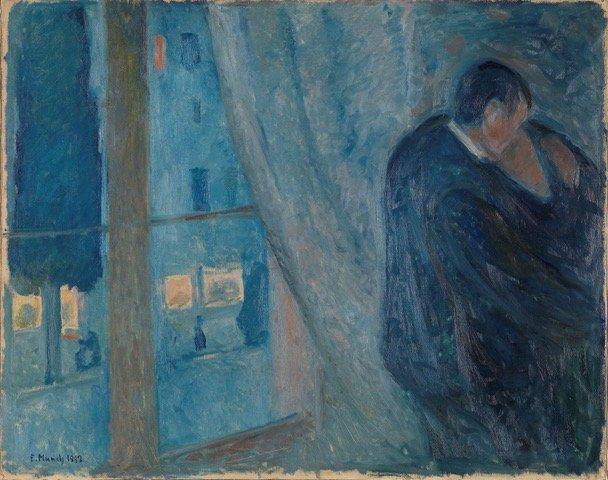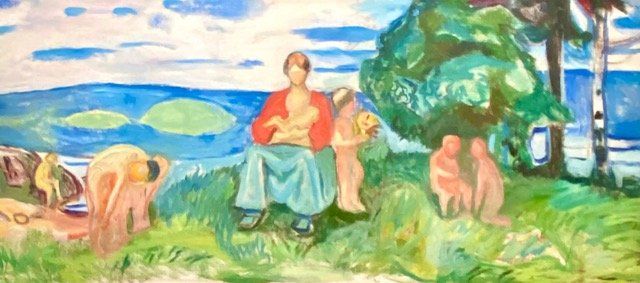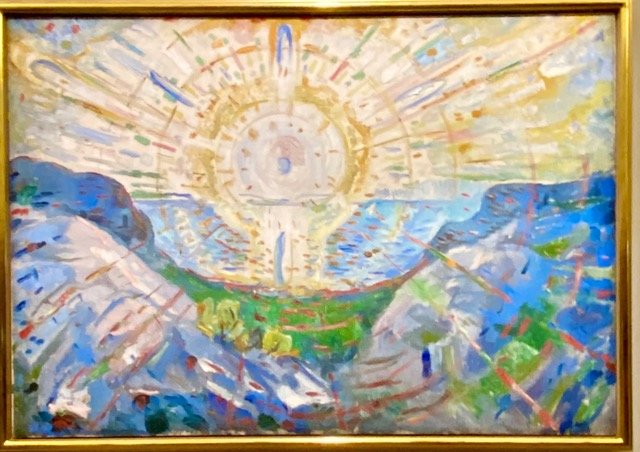Munch: the miseries and mysteries of mankind
Edvard Munch. A Poem of Life, Love and Death. Musée D’Orsay.
You know how some authors are famous for writing one book - like Harper Lee and To Kill a Mockingbird. Although truthfully, if you are a writer and you are only going to write one book, that would be the one to write. Famous artists, too, are often known by one or maybe two of their works. With Leonardo it’s the Mona Lisa and the Last Supper; with Michelangelo, the statue of David and the ceiling of the Sistine Chapel. And so it is with Edvard Munch. Everybody knows The Scream. Even people who don’t know the name of the artist who painted it, know the painting. (Figure 1)
Figure 1. The Scream, Edvard Munch, 1893
If you are thinking about coming to the Musée d’Orsay where there is currently an exhibition dedicated to Munch, and your plan is to take a selfie in front of The Scream, you will be disappointed. None of the four painted versions of The Scream is here. A lithograph is. (Figure 2) Apparently, the Norwegian museums that own three of the versions (one is in private hands) don’t loan them since two have already been stolen, found and returned. Thinking about it, maybe they should reconsider their position since they don’t seem all that safe in their home institutions.
Figure 2. The Scream, Edvard Munch, lithograph, 1895
The exhibition unfolds thematically, a good choice because Munch worked that way, returning again and again to the same subjects. The exhibition explores how Munch’s chosen themes - love, desire, jealousy, anxiety, etc. - developed and changed over time and across media (painting, watercolor, pastels, lithographs, etc.)
Munch’s childhood traumas help make sense of what we know about him as an adult, as an artist. Munch’s mother was 24 when she married Munch’s father, who was 44. She had 5 children in 7 years and then died. Of consumption, tuberculosis. Sophie, Munch’s beloved older sister, died 9 years later, also of consumption. Munch’s own childhood was plagued with illness which kept him at home in bed, weak and sick.
Munch’s father, the son of a minister, was a poorly paid military doctor who raised his children in genteel poverty - very Jane Austen. He was gentle but his kindness was overshadowed by what Munch called ‘morbid pietism’. Anytime one of the children misbehaved, he would tell them that their mother was looking down from heaven and grieving over their behavior. Munch wrote, "My father was temperamentally nervous and obsessively religious - to the point of psychoneurosis. From him I inherited the seeds of madness. The angels of fear, sorrow, and death stood by my side since the day I was born.” For Munch, biology was destiny. He wrote, ”I inherited two of mankind's most frightful enemies … consumption and insanity.”
But just as Frida Kahlo used her physical sufferings in her art, so too did Munch use his mental anguish in his. “My sufferings are part of myself and my art. They are indistinguishable from me, and their destruction would destroy my art.”
As Munch matured and became sexually active, another fear haunted him - the fear of syphilis. Which seems a very rational fear. The roster of men who died of syphilis and complications from syphilis is a virtual who’s who in the art world. Edouard Manet and his brother (Berthe Morisot’s husband). Vincent Van Gogh’s brother Theo. And of course, Gauguin and Toulouse-Lautrec. You’d have to be crazy not to be afraid of getting syphilis. Like Catch 44, that fear proves he wasn’t crazy.
At 17, Munch began studying engineering. He excelled but his frequent illnesses got in the way. So he switched to art. Which brought a change in lifestyle. He hung around with the local bohemians. His father was not pleased. Which made family meals tense. And since he was so poor, Munch mostly ate with his family. When his father got really angry, he stopped giving Edvard money to buy art supplies.
In 1889, Munch received a scholarship to study in Paris. He arrived during the Exposition Universelle - the same time Picasso did. Munch attended painting classes, which he hated, but his afternoons were free to explore museums and exhibitions and of course, experience life in fin de siècle Paris.
He became acquainted with works by van Gogh, Toulouse-Lautrec and Gauguin, all of whom used color to convey emotion. He was inspired by Gauguin's "reaction against realism" and his belief that "art was human work and not an imitation of Nature.”
That first stay in Paris was cut short when his father died in December, 1889. His family destitute, the burden of caring for his two younger sisters fell to him. Munch wrote that he considered suicide, his mother, his father, his sister were dead, why not join them. But a few years later Munch moved to Berlin. And from 1892 until 1908, he split his time between Oslo, Paris and Berlin - with side trips to Italy, too.
That first year in Berlin he held a one man exhibition. On opening day, the Director of the Imperial Academy of Fine Arts demanded that the exhibition be closed because Munch’s paintings were immoral and degenerate. Good to know that the Nazi’s favorite word to describe art they didn’t like was already in fashion, in Germany, at the end of the 19th century. The exhibition closed after a week. Munch became famous, or rather infamous. In protest, avant-garde artists decided to secede from the stodgy Association of Berlin Artists to found their own group - the Berlin Secession.
Negative publicity in Oslo had convinced Munch never to show his work with other painters. The fiasco in Berlin convinced him that the only way to show his art was to arrange the works thematically. By the end of 1893, he was exhibiting his first series in Berlin. Munch wrote, “the paintings are moods, impressions of the life of the soul, and together they represent one aspect of the battle, between man and woman, that is called love.”
In that first group, there were six paintings. The collection eventually grew to 22. And until 1908, he displayed them in Berlin, using the title, Frieze of Life. His works explore human emotions from love and heartache to jealousy, loss and despair. Sales were never good (he made money by charging an entrance fee), but that didn’t bother Munch. His paintings were his children and he sold them reluctantly. When he did, he replaced them with other versions of the same subject.
Munch represented love with ‘Kiss by the Window,’ first painted in 1892.(Figure 3) A couple embrace on the right. In this first version, the canvas is mostly given over to the scene beyond the window. In 1897, Munch has moved the couple to center stage. (Figure 4) The world beyond has shrunk. In a woodcut from that same year, the outside world is gone. (Figure 5) In every version, the man’s and woman’s faces are fused. One critic noted that the French word for fusion, ’fusionnel’ perfectly describes this couple, two people who are as one, whose individual identities have disappeared.
Figure 3. Kiss by the Window, Edvard Munch, 1893
Figure 4. The Kiss by the Window, Edvard Munch, 1897
Figure 5. The Kiss, Edvard Munch, Woodcut 1897-1902
In Munch’s "Love and Pain” now known as “Vampire,” (Figure 6) the couple embraces, but it is not the loving embrace of The Kiss. Munch said the painting was of a woman kissing a man’s neck. Maybe it is only that - a man finding solace in a woman’s lap as she finds the same in his shoulder. But I see a man overpowered by a woman’s embrace, unable to extract himself, her hair a web from which he cannot escape. The woman is biting the man’s neck, sucking his blood, Vampire.
Figure 6. Love and Pain (also known as Vampire) Edvard Munch, 1893
In Munch’s work, a woman’s hair is sometimes a temptation, more often a weapon. The woman uses her hair to entrap a man. He becomes entangled in a web from which he cannot escape.
Calling the painting of a languorous female nude whose head is thrust back and whose eyes are closed, Madonna (Figure 7) seems a stretch, even if she does have a halo, albeit a red one. This erotic image includes the man only if we imagine him to be the voyeur. But for the next iteration, the lith0graph, the frame completes the story, spermatozoa float and a fetus cowers in the left bottom corner. (Figure 8)
Figure 7. Madonna, Edvard Munch, 1894
Figure 8, Madonna, Edvard Munch, lithograph, 1895
Next in the series is Woman in Three Stages. (Figure 9) On the left, a young woman in profile, modestly dressed in white, gazes toward the sea and sky. Her long blond hair flows down, a stream connects her to the central female. Nude, facing us, her arms behind her head. She is the woman from Vampire. On the right is a woman somberly dressed in black, diminutive and overshadowed. Beyond her, is a man, face downturned, looking away. He is separated from the women by a red post, not part of this unfolding drama of youth, maturity and old age.
Figure 9. Woman in Three Stages, Edvard Munch, 1895
Separation (1896) (Figure 10) is the next painting in the series. The young, virginal woman with long blond hair from the previous painting is now on the right. She looks out to sea, her hair again flows down her back and now also behind her, towards the young man on the left. Dressed in black, he leans against a tree and clutches his heart with a red hand. She is all beauty, purity, innocence. He is all despair, regret and pain.
Figure 10. Separation, Edvard Munch, 1896
And then there is Jealousy (1895). (Figure 11) Munch’s paintings are often autobiographical. This painting certainly is. In the background a female figure (Eve), (un)dressed in red, pulls an apple from a tree and offers it to the man standing next to her. In the foreground, removed from the two figures but affected by them is Munch’s Polish poet friend, Stainislaw Przybyszewski. The man receiving the apple from the temptress is Munch. The woman giving him the apple is his friend’s wife. Munch had painted her two years earlier, the year she married the poet, the year her affair with Munch began.
Figure 11. Jealousy, Edvard Munch, 1895
Munch’s “Frieze of Life” includes images that don’t deal specifically with the conflict between men and women. Evening on Karl Johan Street (1892) (Figure 12) could be dubbed The Night of the Living Dead. Zombie like pedestrians, packed together, looking without seeing, moving without walking, as if on a conveyor belt. A lone figure in the middle distance walks away. Munch described waiting for his mistress one evening. As he waited, strange and awkward people passed by. He felt as if they were staring at him. Another critic sees “(a) single figure moving against the flow … evok(ing) Munch's own situation as a 'bohemian' and radical artist, hounded by the middle-class authorities in the stifling parochialism of Christiania….”
Figure 12. Evening on Karl Johan Street, Edvard Munch, 1892
Anxiety (1894) (Figure 13) was painted a year after Munch’s best known painting, The Scream. Some of the people from Evening on Karl Johan Street are here. But they are no longer walking along a city street. They are at the same jetty as the figures in The Scream. (see above, Figure 1) The same lake is in the distance, the same swirling, nightmarish sky. Munch made lithographs and woodcuts of them both. (Figure 14) These mediums distill and intensify the mood of the paintings.
Figure 13, Anxiety, Edvard Munch, 1894
Figure 14. Anxiety, Edvard Munch, woodcut, 1896
Munch once explained the circumstances surrounding The Scream. He had been walking with two companions. After they turned back, he continued, alone. Then he heard a piercing scream, as if coming directly from nature. While the figure in the foreground may refer to Munch, this is a genderless creature - closer to ET (Figure 15) than the little boy in Home Alone. (Figures 16, 17) No other figure in Munch’s oeuvre is as far from human as this figure is. At the top of one version, Munch wrote: 'Can only have been painted by a madman.’ The painting has become a cultural icon that, according to one critic, “perfectly sums up the uncertainty, loneliness and dread of our modern age.”
Figure 15. E.T.
Figure 16. Screaming Face, Edvard Munch
Figure 17. Home Alone
There are so many other paintings I could tell you about. Puberty from 1894, and part of the Frieze of Life series, shows a young girl, her eyes wide open, naked and vulnerable, on the cusp of womanhood. (Figure 18) And Death of Marat from 1907, (Figure 19) a reference to Charlotte Corday’s stabbing of the French revolutionary Marat and Munch’s own troubled relationship with Tulla Larsen, to whom he was engaged but never married. After a particularly violent fight which involved a gun, his left hand was injured (self inflicted or by her? He blamed her). The painting shows him fully prone, and bleeding. Her, fully upright and immobile. Both perfectly naked.
Figure 18. Puberty, Edvard Munch, 1894
Figure 19. Death of Marat, Edvard Munch, 1907
Then there are his self portraits, each an exercise in self analysis. (Figures 20, 21) And his work for the major dramatists of the day, among them Ibsen and Strindberg.
Figure 20. Self portrait, Edvard Munch 1895, a young man
Figure 21. Self Portrait, Between the Clock and the Bed, Edvard Munch, 1943, an old man confronting death
And this last one. Among Munch’s final paintings are murals for the Assembly Hall of the University of Oslo. It wasn’t a commission but a competition, which Munch did not win. But no-one else did either, so he began lobbying for it. He was finally awarded the commission to paint eleven gigantic, colorful murals (Figures 22, 23). Munch declared: "I wanted the decorations to form a complete and independent world of ideas, and I wanted their visual expression to be both distinctively Norwegian and universally human.”
Figure 22. Maternity, Edvard Munch, University of Oslo (1914 -16)
Figure 23. The Sun, Edvard Munch, University of Oslo (1914-16)
Vita brevis et ars longa (Life is short and art is long) so I will end here. Hopefully, you are not sated but still hungry for more about this most fascinating artist.
Copyright © 2022 Beverly Held, Ph.D. All rights reserved
Dear Reader, I hope you enjoyed reading this article. Please sign up below to receive more articles plus other original content from me, Dr. B. Merci!
And, if you enjoyed reading this review, please consider writing a comment. Thank you.























